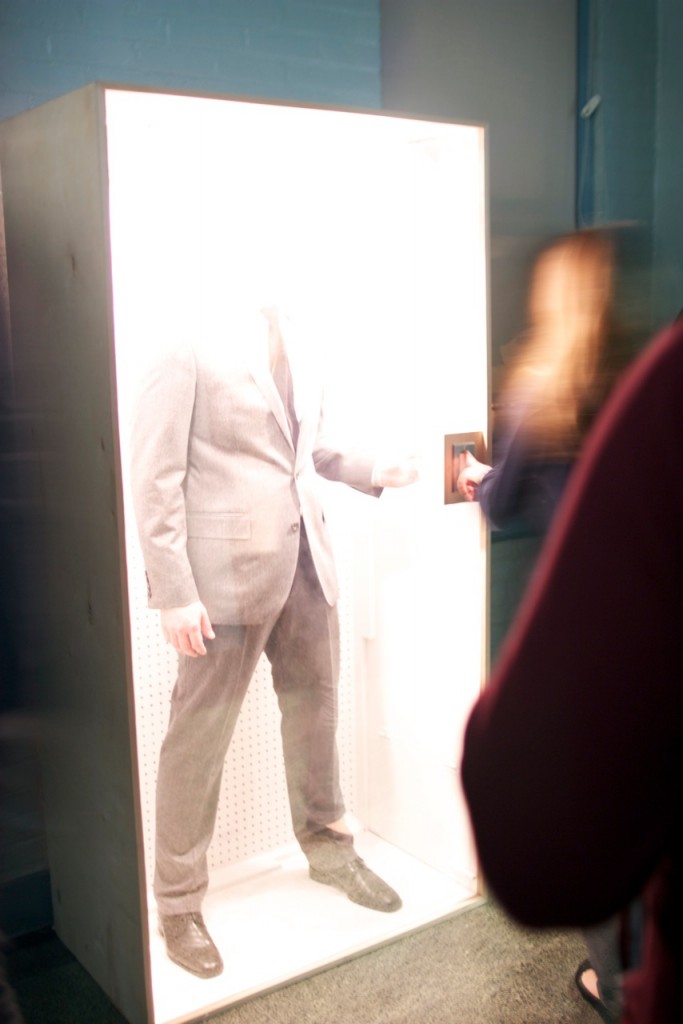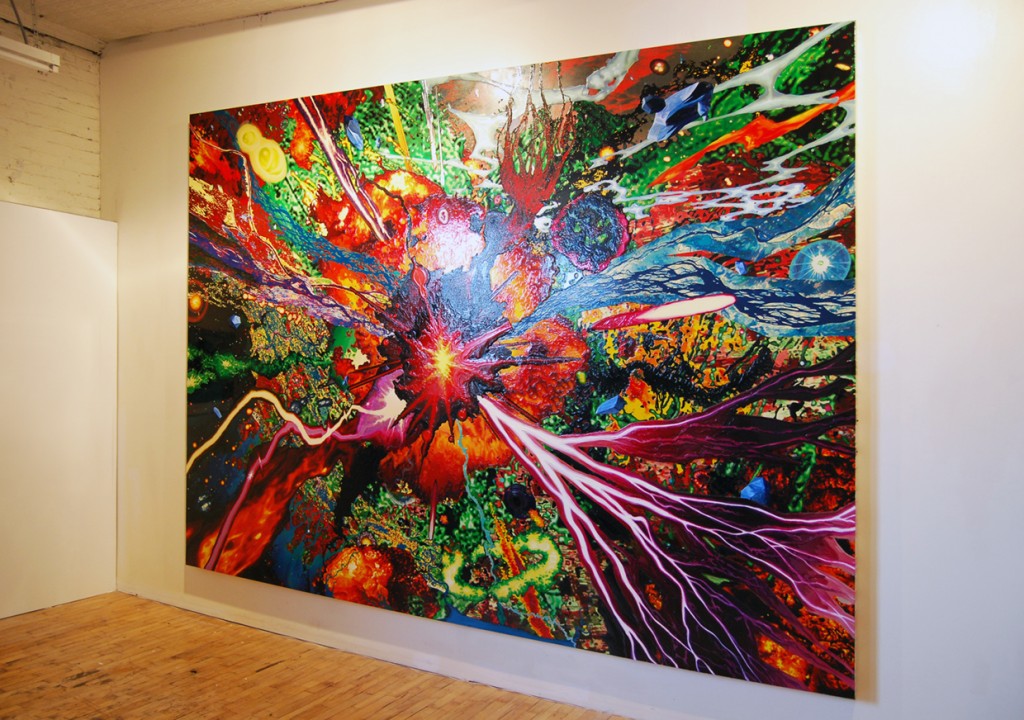A young woman rounds the corner and catches a glimpse of her reflection in a full-length mirrored box. Attracted to this, she stops to make sure her bangs are okay, and notices that the mirror also has a switch, at perfect doorbell height. Curious, she flips the switch, only to immediately jump back, letting out a half scream, half laugh. She might be going crazy, she thinks, but she swears she just saw her reflection change into that of a man’s. Intrigued, she presses the switch a second time, and registers the flashing image of him again. Sure enough, inside the two-way mirror is a man, about 6’, standing at the ready, in a grey suit with a black tie. He has the appearance of James Bond, but the moxy of Elvis Presley vis-à-vis Andy Warhol’s prints. This man also has an identically placed switch on his side of the mirror. While the young woman can turn on the light, revealing the man, he has the power to turn the light off. The young woman giggles, fascinated by her power, yet she still feels the need to touch the switch again, and sees the opportunity to compete; a game ensues. She continuously turns on the light, as fast as she can, trying to reveal the man, to find out who he is, and what he looks like. He is calm and quick to the switch; she is relentless. She giggles more and more, and he remains stone cold 007, intensely staring into her eyes. You can see he is sweating, somewhat annoyed yet maintaining his authority, which fuels this woman’s sadistic tendencies even more. Who will win?
Eventually, she grows tired of hitting the switch so many times, hoping to tire him out, hoping to see him give up. He finally breaks, and the two individuals share a moment of recognition. She backs away, and he turns the light off, deviously waiting in the dark box for the next person to discover the game. The man is Oliver Warden, a Brooklyn-based painter, photographer, performance artist, and videogamer (of all things). The performance, Untitled Box 2.0, is a concept that was originally devised in 1993 (as Untitled Box) while the artist was in school, and realized for the second time nearly 20 years later in November 2010 at Physical Center, a night of performance and installation at Former Convent of Saint Cecilia in Brooklyn, NY. The piece was performed most recently at School Nite, an exhibition in partner with the New Museum’s Festival of Ideas in May 2011, in Manhattan. Untitled Box 2.0 is a piece that speaks directly to the viewer’s most immediate feelings of art viewing: surprise, mystery, and humor. From another point of view, Untitled Box 2.0 is about many things: pop art, masochism, the Internet & social networking and analogous topics like voyeurship and surveillance, as well formal themes such as the artist/viewer interaction.
Firstly, it is inescapable to draw comparisons of Oliver Warden’s performance in Untitled Box with Andy Warhol’s screenprinted paintings of Elvis Presley, posing as his character, Pacer Burton, in The Flaming Star (1960). Both men are positioned in an at-the-ready stance, feet slightly wider than shoulder-width distance, one hand drawn (either with a pistol or to flip the light switch), and sporting a wide-eyed, determined gaze. Warhol, the master of Pop Art, explored pop culture through celebrity iconography and multiplicity in advertising. Warden, on the other hand, is not working within with these themes; rather, the majority of his body of work deals with pop technology, such as gaming, virtual reality, and social networking. Therefore, only formal comparisons can be drawn, however the similarities are undeniable.
Oliver Warden (b. 1971, Cleveland, Ohio) is a multidisciplinary artist, working both in the realms of contemporary art and technology. When online, he goes as his avatar name, ROBOTBIGFOOT. The majority of his body of work is inspired by and culled from his experiences in the virtual world, as he spends about 40 hours a week inside the realms of Counter-Strike, Left 4 Dead, and various independent titles. It can be said that Warden essentially, and by 21st Century definition, lives in two worlds: online and off. His paintings, ranging in size of 1 ft to 21 ft canvases, are made by a unique process of pouring Galkyd onto canvas laid horizontally in his Bushwick studio. The semi-transparent and glossy layers build over each other in intricate and elaborate geographies, creating an effects-driven and technologically mediated super-world. His cameraless-photography is created on his computer, in virtual spaces. One series that I find especially innovative shows the “edge of world” in the video game Tribes; Warden literally played the game until there were no more challenges or objectives to complete, and after reaching the literal end of the map (where the playable area stops), he took thousands of screen shots. The results are works on paper, presented as pixelated photographs. His performance pieces are the third factor of his work, creating a complete balanced and intentional body. Inspired by his interactive experiences, he built a body of work around notions of privacy, voyeurship and control. Stalking people in Central Park at midnight and “capturing” them on video, living in a school wall for a week and pulling covert ops at night and sitting inside a chair as unknowing sitters sat on his lap, all challenged and occasionally broke the rules of engagement and participation.
How is Untitled Box 2.0 different in 1993 and 2010? How did it change over the years, and why is is relevant that Warden first performed the piece in 1993? The piece was conceived at the cusp of the Internet-era, before terms like social media, tweeting, and skyping was common language. The idea was inspired by a culture that was exploding with hype about interactivity, and increased immediacy in national and international communication. Today, there are countless scholars writing novels and textbooks about extracting a movement or shift in contemporary thinking and philosophies in the Internet age. 20 years ago, we were wondering what possibilities the Internet would bring; today, we are wondering how it is adversely impacting our society, and how far it’s going to go. In the early 90s, most people still had private lives, or rather, one life. Today, in 2011, we have our real lives, and our virutal lives. We have our real address, and our email address; our job history, and our google-search engine history; our real friends and our facebook friends. Most dramatically, in the nineties, most people could only imagine the possibility of meeting strangers in chatrooms, calling a friend via videocam, or being able to meet up with (real) friends, in physical spaces, by ‘checking in’ or ’shouting out’. It was the beginning of a millennial phenomenon to put oneself out into the virtual world, with little concern for privacy or emotional repercussions.
At the beginning, these ideas were novel, intriguing, and we waited with impatience. Today, there is a general feeling of paranoia with applications like foursquare, facebook, or Chatroulette; if you are present in the Internet community (even the most in-active kind of member), you are never alone, and you can never be alone. With Untitled Box 2.0, Warden reduces interactivity to its most essential components: on-off, you-me, inside-outside. The result is something everyone can understand and participate with – a base language, a fundamental duality, a bit code. Like a computer code that is written between the artist and participant, our interaction makes the work have a life, and therefore content, that exists for as long as the two parties work to keep it alive. Essentially, Untitled Box 2.0, is about the Internet and social media at its most fundamental form: we are reaching out to each other, at a distance, but who has the control and how do we know when is the right time to stop?
You can learn a lot about a person by seeing how they interact with Untitled Box 2.0. Even though the viewer can turn on the light in the box whenever they want and how often they want to, Warden acts as the ultimate eye. He can watch people in the room when they can’t see him, he can watch their reactions, and hear what they have to say. He can see the viewer/participator, even when they aren’t even aware that he is inside the box. He can see their reaction, their facial expressions and body language, their insecurites and their character. They make themselves vulnerable to his surveillance (although, as a participant has control of the switch, it is easy to prematurely conclude that one has control over the artist). Often, he loses this power to aggressive participators, sometimes for minutes on end. The result for him is a bombardment of light and noise and burning 500 Watt lamps, which sometime reach a tortuous state. Warden however stays silent; so many viewers forget or fail to acknowledge that he is listening to them. On facebook, there is a questionable and interesting feature called Poke or Poking. It allows you to call someone’s attention by virtually “poking” him or her. In a way, it feels like Warden is humanizing the facebook experience, by making this “poking” function real and physically participatory. The resulting experience creates heightened emotions, both in excitement and awkwardness, embarrassment and empathy.
Oliver Warden will be performing Untitled Box 2.0 twice this week, on Sat, Oct 29 at the Gowanus Studio Space from 9pm – 4am and again on Mon, Oct 31, at The Delancey, from 8pm – 1am. Additionally, his paintings can be seen in two upcoming group exhibitions, at Allegra LaViola, Die Like You Really Mean It, opening on Oct 26, and at Camel Art Space, in Space Over Time, opening Nov 4.




 RSS
RSS
